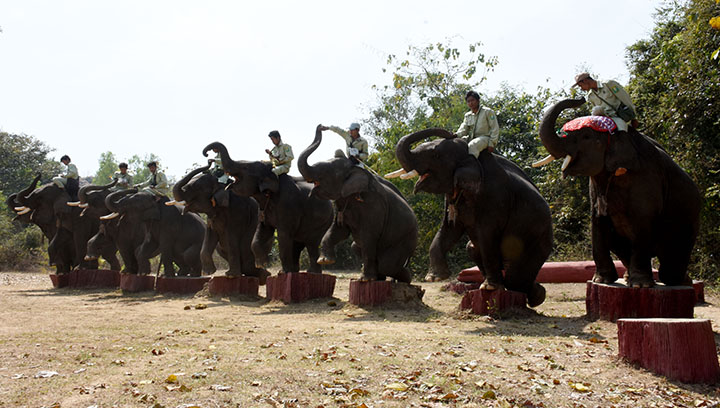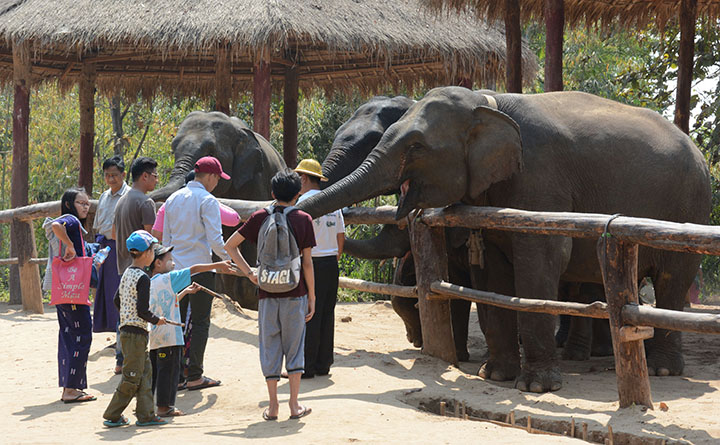By Tommy Pauk
World Elephant Day was observed in Myanmar on 12 August to help people understand the need for preserving and protecting the giant mammals. Observance of such days is one way people from across the world can be brought together to help the elephants. It has become necessary to raise awareness about the urgent need for saving these intelligent mammals from extinction. Some countries are working to bring attention to the chances of African and Asian elephants becoming extinct, unless efforts are made for their conservation.

As for the country Myanmar, we Myanmar regard elephant as a precious animal. Besides, we use them for our traditional or auspicious ceremonies or events like novitiation ceremonies and royal ceremonies . It is very significant that the familiar relationship between tamed elephants and Myanmars can be learnt. According to the historical records, King Mindon had issued the directives for the systematic conservation of wildlife elephants as well as captive elephants in the country. Geographically, Myanmar has a good and favorable habitat for Asian elephants in wild life and they have been caught and tamed for timber extraction and Royal Army since the successive reigns of Myanmar monarchs. Thus, some of them have become captive elephants and they get familiar with Oozies or Mahouts involved in State-owned Timber Extraction and dutiful to their log-carrying work properly. Nowadays, the elephants in wild life encounter narrow habitat and inadequate natural food due to deforestation and impact of climate change. Even then, Illegal elephant poaching and illegal ivory trade are threatening to the survival of wild elephants in the forests in the world.
As a result, the world elephant population is significantly declining. The number of elephants in Myanmar is also declining. People, governments, and animal lovers around the world have realized that they need to protect elephants through proper care and management to ensure the future of the species on the Earth. Myanmar too has laid down the conservation project of wild elephants as well as captive elephant management. Moreover, many countries consider elephants the endangered species and demand ending the practice of capturing elephants and sending them to zoos and entertainment venues around the world.
In 2015, the Forest Department had laid down a plan called Myanmar Elephant Conservation Action Plan (MECAP ). Now it has been implementing. In line with the prescribed law, the license for private ownership of elephant known as elephant- grant- license can be obtained through the processes of registration and submission of application. Captive elephants are owned by state-owned Myanma Timber Enterprise and private-owned individuals. The welfare and healthcare captive elephants in the work of MTE (Myanma Timber Enterprise ) are systematically managed by authorities concerned.
Management of MTE for captive elephants involved or engaged in the timber extraction work is as follows;-
• Three mobile clinic vehicles staffed with veterinarians and INGOs members are carrying out healthcare activities in the areas where the captive elephants engaged with MTE work
• Since timber production has declined, MTE-owned captive elephants stand idle. Therefore, they are put in elephant conservation based tourism.
• Baby elephants from MTE and wildlife baby elephants (orphans) are conserved by MTE.
• Currently, 1721 adult elephants ,748 loader elephants, 613 calves totaling 3082 elephants are being conserved by MTE
• MTE has already formed 10 units of Emergency Elephant Response Units to conserve wild elephants with the collaboration of Myanmar International Elephant Foundation and Smithsonian Conservation Biology Institute
• In 2017-2018 fiscal years, arresting the elephant poachers, seizing the weapons and regular patrolling had been carried out.
• Elephant releasing or Rewilding must be carried out due to the increasing numbers of captive elephants and declining number of wild elephants in the wildlife.
The above-stated are the actual situation and Myanmar is striving for conserving elephants and how the captive elephants are being used for country's tourism and public recreation. Particularly, the tamed elephants are very helpful for our traditional ceremony, timber extraction and entertainment. Obligingly, we are ready to cooperate with international organizations related to wildlife and captive elephant conservation scheme. Since we love elephants, the government, public and stakeholders will help wild and captive elephants for maintaining their survival and natural habitat in our country. To summarize the article, it is learnt that Myanmar is currently working together with WWF – Myanmar (World Wide Fund For Nature ), International Elephant Foundation and Smithsonian Conservation Biology Institute for preserving, protecting and expanding the habitat of wild life elephants in Myanmar. In addition, Myanmar complies the ban on using captive elephants in hard labor and in the condition of harsh riding on them. In conclusion, Myanmar is striving for maintaining and nurturing the huge land mammal- elephant species in Myanmar constantly.
References: Wikipedia, Captive Elephant Management Workshop held at Summit ParkView in Yangon on 30-31 August 2018.



